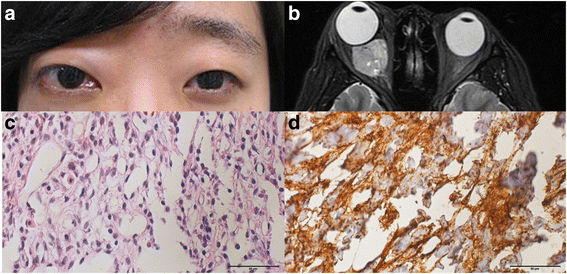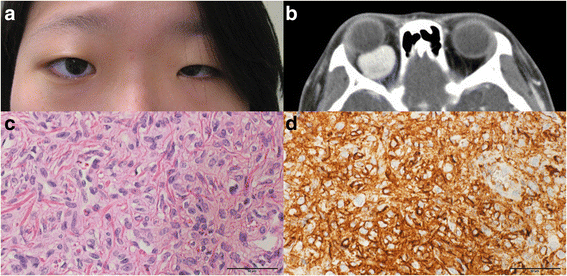CD34 + tumours of the orbit including solitary fibrous tumours: a six-case series
- PMID: 28449640
- PMCID: PMC5408362
- DOI: 10.1186/s12886-017-0455-x
CD34 + tumours of the orbit including solitary fibrous tumours: a six-case series
Abstract
Background: To report six cases of CD34+ fibroblastic mesenchymal tumours, which are uncommon neoplasms in the orbit.
Case presentation: Six patients presenting with proptosis and palpable mass who were later diagnosed with fibrous solitary tumours, fibrous histocytoma or haemangiopericytoma in the orbit were included. All patients received radiologic examinations and surgical excision for histopathology and immunohistochemistry examinations. Five patients had no recurrence after a minimum follow-up of 12 months. One patient (case 6) experienced recurrence twice, and had debulking surgeries each time. At present, the patient still has remnant tumour in the orbit, but no growth has been detected during the past two years. The tumour size will be closely monitored.
Conclusions: Even though fibroblastic tumours are rarely found in the orbit, they can present as a palpable mass with proptosis. Complete surgical excision is important for long-term prognosis, and immunohistochemical study is helpful for confirming pathologic diagnosis.
Keywords: CD34; Fibrous histiocytoma; Haemangiopericytoma; Mesenchymal tumour; Solitary fibrous tumour.
Figures






Similar articles
-
Orbital solitary fibrous tumor: encompassing terminology for hemangiopericytoma, giant cell angiofibroma, and fibrous histiocytoma of the orbit: reappraisal of 41 cases.Hum Pathol. 2011 Jan;42(1):120-8. doi: 10.1016/j.humpath.2010.05.021. Epub 2010 Nov 5. Hum Pathol. 2011. PMID: 21056898
-
A review of solitary fibrous tumours of the orbit and ocular adnexa.Eye (Lond). 2023 Apr;37(5):858-865. doi: 10.1038/s41433-022-02160-w. Epub 2022 Jul 13. Eye (Lond). 2023. PMID: 35831617 Free PMC article. Review.
-
Malignant solitary fibrous tumour of the orbit.Acta Ophthalmol. 2009 Jun;87(4):464-7. doi: 10.1111/j.1755-3768.2008.01290.x. Epub 2008 Sep 24. Acta Ophthalmol. 2009. PMID: 18823286 Review.
-
Solitary fibrous tumor of the orbit with epithelioid features.Arch Pathol Lab Med. 2006 Jul;130(7):1039-41. doi: 10.5858/2006-130-1039-SFTOTO. Arch Pathol Lab Med. 2006. PMID: 16831031
-
Solitary Fibrous Tumor of the Orbit: A Case Report and Review of the Literature.Turk Neurosurg. 2015;25(6):984-7. doi: 10.5137/1019-5149.JTN.11183-14.1. Turk Neurosurg. 2015. PMID: 26617156 Review.
Cited by
-
Orbital solitary fibrous tumors: a multi-centered histopathological and immunohistochemical analysis with radiological description.Ann Saudi Med. 2020 May-Jun;40(3):227-233. doi: 10.5144/0256-4947.2020.227. Epub 2020 Jun 4. Ann Saudi Med. 2020. PMID: 32493043 Free PMC article.
-
Solitary fibrous tumor of the orbit with growth during pregnancy: a case report.Orbit. 2019 Jun;38(3):256-258. doi: 10.1080/01676830.2018.1474930. Epub 2018 May 21. Orbit. 2019. PMID: 29781760 Free PMC article.
-
Orbit Solitary Fibrous Tumor: A Proposed Risk Prediction Model Based on a Case Series and Comprehensive Literature Review.Head Neck Pathol. 2021 Mar;15(1):138-152. doi: 10.1007/s12105-020-01184-6. Epub 2020 Jun 11. Head Neck Pathol. 2021. PMID: 32529350 Free PMC article. Review.
-
Orbital Solitary Fibrous Tumor: Four Case Reports-Clinical and Histopathological Features.Case Rep Ophthalmol Med. 2021 Jun 9;2021:5822859. doi: 10.1155/2021/5822859. eCollection 2021. Case Rep Ophthalmol Med. 2021. PMID: 34211794 Free PMC article.
-
Solitary Fibrous Tumor of the Orbit: A Case Series With Clinicopathologic Correlation and Evaluation of STAT6 as a Diagnostic Marker.Ophthalmic Plast Reconstr Surg. 2020 Mar/Apr;36(2):164-171. doi: 10.1097/IOP.0000000000001504. Ophthalmic Plast Reconstr Surg. 2020. PMID: 31876648 Free PMC article.
References
-
- Furusato E, Valenzuela IA, Fanburg-Smith JC, Auerbach A, Furusato B, Cameron JD, Rushing EJ. Orbital solitary fibrous tumor: encompassing terminology for hemangiopericytoma, giant cell angiofibroma, and fibrous histiocytoma of the orbit: reappraisal of 41 cases. Hum Pathol. 2011;42(1):120–128. doi: 10.1016/j.humpath.2010.05.021. - DOI - PubMed
-
- Brunnemann RB, Ro JY, Ordonez NG, Mooney J, El-Naggar AK, Ayala AG. Extrapleural solitary fibrous tumor: a clinicopathologic study of 24 cases. Mod Pathol. 1999;12(11):1034–1042. - PubMed
Publication types
MeSH terms
Substances
LinkOut - more resources
Full Text Sources
Other Literature Sources
Miscellaneous

